This Date In Transactions History: Bengals Cut Terrelle Pryor
On this date in 2015, the Bengals released quarterback Terrelle Pryor. After four unremarkable years in the NFL, the move didn’t mean much at the time. However, the release changed the trajectory of the former Ohio State star’s career. 
The late Al Davis brought Pryor into the league after selecting him in the third round of the 2011 supplemental draft. Pryor didn’t play much in his first two seasons and struggled on the whole in 2013, although there were some impressive moments. Pryor was traded to the Seahawks in 2014, but was cut prior to Week 1 and wound up sitting out of football altogether that year. In January of 2015, the Chiefs signed Pryor, but released him in May. The Bengals scooped him up, but cut him from the roster five weeks later on June 18, 2015.
Clearly, Pryor’s athleticism could not carry him at the quarterback position in the NFL, but he was reluctant to give up on his lifelong dream. Prior to signing with the Bengals, Pryor declared, “If I can’t play quarterback, I can’t play football.” But, after his release from the Bengals, agent Drew Rosenhaus informed teams that Pryor was willing to line up as a wide receiver.
Ohio’s other team – the Browns – moved quickly to claim Pryor off of waivers. Pryor didn’t see much time on the field in that season, but things changed when the Browns shifted him to wide receiver prior to the 2016 offseason. The Browns were optimistic about what the 6’4″, 228-pound athlete could do at his new position, but few expected him to finish the season with 77 catches for 1,007 yards and four touchdowns.
Pryor parlayed his huge season into a one-year, $6MM free agent deal with the Redskins, but he was held back by an ankle injury and did little in D.C. He tried to regain his footing with the Jets last year, but injuries got the best of him once again. After his midseason release, his deal with the Bills amounted to nothing more than a cup of coffee.
Pryor resurfaced again in May when he signed a veteran’s minimum contract with the Jaguars. The former quarterback could have an opportunity to stand out in Jacksonville’s lackluster WR group, if he’s healthy.
Buccaneers, Mike Evans Rework Contract
The Buccaneers have done a simple restructure on wide receiver Mike Evans’ contract, as Tom Pelissero of NFL.com tweets. The adjustment will create an additional $3.2MM in cap space, though Evans will still earn $20MM in cash this year. 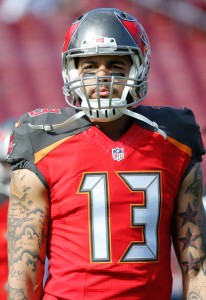
[RELATED: Former Bucs QB Josh McCown Retires From NFL]
Heading into Tuesday, the Bucs had roughly $4.7MM in cap room. By adjusting Evans’ deal, the Bucs will have about $8MM to use on late-stage free agents and address some of their own players.
Evans, 26 in August, inked a five-year, $82.5MM extension with the Bucs last offseason. With incentives, Evans has the ability to earn nearly $96MM over the course of the pact. This marks the second time that Evans has adjusted his contract this offseason, though the previous revision did not address the Bucs’ cap situation.
Even with a fat new contract in hand, Evans did not rest on his laurels in 2018. The wide receiver earned his second career Pro Bowl nod as he hauled in 86 catches with a career-high 1,524 yards. He also set a new career best in yards-per-catch with 17.7 per reception and scored eight touchdowns.
East Rumors: Witten, Mills, Patriots, Giants
With minicamps having concluded, we are now in NFL’s true offseason. However, teams use this downtime to size up their rosters and determine which, if any, moves need to be made. Here is how some of the East franchises’ rosters look going into the break:
- At first, Jason Witten‘s unretirement was believed to be centered around a part-time on-field role and for off-field leadership. But after the Cowboys‘ offseason program, Todd Archer of ESPN.com insists the 37-year-old tight end will play far more than the 25-snap role loosely pegged for the one-year ESPNer upon his return. Witten caught at least 60 passes from 2004-17, so it can be expected the Cowboys want to see him provide Dak Prescott with as much of a short- and mid-range option as he can handle in his comeback year. Backup Blake Jarwin (27 catches, 307 yards in 2018) did grade as Pro Football Focus’ No. 25 tight end last season, so it’s logical the team will use him plenty.
- The Dolphins‘ initial hope was to slot former Bills starter Jordan Mills at the right tackle spot Ja’Wuan James‘ departure vacated, but that has not gone so well. Mills did not fare well during much of Miami’s minicamp, according to ESPN.com’s Cameron Wolfe, who writes Mills (48 starts as Buffalo’s right tackle since 2016) was “regularly exposed” during workouts. While it’s hard to tell how linemen are performing until the pads come on, and this Mills update runs counter to a report indicating right tackle was his job to lose. But Wolfe adds Jesse Davis replaced Mills during some practice sessions. The Dolphins would save $2MM by releasing Mills, who has started 82 games in six seasons.
- Despite not his nomadic stretch since his Chargers days, Dontrelle Inman fared well as a Colts supporting-caster last season. He graded as one of the best part-time wideouts in the league, per Football Outsiders. But Jeff Howe and Nick Underhill of The Athletic leave the 30-year-old receiver off their Patriots‘ 53-man roster projection (subscription required), even in predicting Demaryius Thomas starts the season on the PUP list. The duo only have four true wideouts (Julian Edelman, N’Keal Harry, Maurice Harris, Phillip Dorsett) making the Pats’ roster, with Matthew Slater long used as a pure special-teamer. The Pats guaranteed Inman $300K.
- The first post-Odell Beckham Jr. Giants receiving corps features clear-cut starters in Sterling Shepard and Golden Tate, but a Day 3 rookie may have an outside shot at being New York’s WR3. While Corey Coleman stands as Big Blue’s current No. 3 wideout, Ralph Vacchiano of SNY notes fifth-round pick Darius Slayton (Auburn) has a decent chance to supplant him. Pat Shurmur called Slayton the team’s most improved player this offseason, and Jordan Raanan of ESPN.com added the team seeks a downfield threat to team with Tate and Shepard. Slayton averaged at least 19 yards per catch in each of his three Auburn seasons.
North Notes: Packers, Rudolph, Steelers
The freedom Aaron Rodgers may or may not have to change plays at the line of scrimmage has become an issue in Green Bay, and first-year Packers HC Matt LaFleur explained the concern he has with enabling his decorated quarterback to have the kind of pre-snap autonomy he did under Mike McCarthy.
“One thing we have to work through is the audible thing,” LaFleur said, via Michael Silver of NFL.com, of his conversations with Rodgers. “We’re running a system I first picked up while working with Kyle (Shanahan) in Houston a decade ago, and we’ve never really had a quarterback who’s had complete freedom to change plays at the line, because that’s not really the way the offense is set up. But, I mean, this is Aaron Rodgers. He’s had a lot of freedom to make those calls, and deservedly so. Now, how do we reconcile that, and get to a place where we put him in the best position to succeed?”
LaFleur would prefer Rodgers only have one play he can check to, while the 15th-year passer would like more leeway. The former Rams and Titans OC cited the pre-snap movement he’s bringing to Green Bay as a reason for the potential constraints Rodgers will face.
“We move a lot more. There’s a lot more motion. There are a lot more moving parts,” LaFleur said, via Silver. “And so if you just let the quarterback have that freedom to just get to whatever, I’m afraid it would slow our guys down. Now, he is a special talent and he’s got an incredible mind, so as we move forward throughout this process he’s getting more freedom. It’s just, where is that happy medium?”
Let’s look at the latest news out of the North divisions:
- Although Kyle Rudolph received the outcome he wanted — a four-year, $36MM Vikings extension — he acknowledged the prospect of a Patriots trade. But it’s still unclear if the teams engaged in discussions. “Obviously the speculation is going to be there because of their situation at my position and then our team’s cash/cap situation and my salary,” Rudolph said, via SI.com’s Albert Breer. “So there was kind of just a natural, like, ‘Hey, Kyle’s familiar with the offense, he played for a coach (Charlie Weis, at Notre Dame) that was a coordinator there.” After signing Austin Seferian-Jenkins and Ben Watson, then cutting ASJ and nixing the Michael Roberts trade with the Lions, the Patriots still face the prospect of not having a proven tight end during Watson’s suspension.
- The buzz about Donte Moncrief becoming Ben Roethlisberger‘s No. 2 target continues, with Mark Kaboly of The Athletic (subscription required) calling it a “slam dunk” the former Colts and Jaguars wideout will be the Steelers’ WR2. It still figures to be a collaborative effort replacing one of this generation’s best players, Antonio Brown, but it looks like Moncrief’s offseason has him in position to lead that charge.
- Artie Burns‘ standing in Pittsburgh is certainly not on the same level, and the Steelers face a decision on the underwhelming first-round cornerback. The team has until the third day of training camp to waive Burns and save $800K, but Kaboly notes that if the fourth-year corner has not yet been cut, the Steelers are probably planning to give him another shot. Regardless, Kaboly expects this to be Burns’ final year in Pittsburgh.
Caserio Fallout: Pats, Texans, Kraft, Staff
The complex process that has taken shape since the Texans fired Brian Gaine still leaves the franchise without a GM, and, as of now at least, it looks like the Patriots will need to prepare for a front office shakeup in 2020.
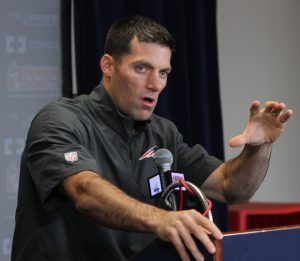 Although the Texans are no longer pursuing top GM target Nick Caserio, and the Patriots have since dropped the tampering charges, the longtime Pats player personnel director is reportedly prepared to leave New England after his contract expires in 2020. The Texans are considering going without a GM this year, likely in hopes of landing Caserio next year, but they obviously run the risk of another potentially GM-needy team swooping in for the long-coveted executive.
Although the Texans are no longer pursuing top GM target Nick Caserio, and the Patriots have since dropped the tampering charges, the longtime Pats player personnel director is reportedly prepared to leave New England after his contract expires in 2020. The Texans are considering going without a GM this year, likely in hopes of landing Caserio next year, but they obviously run the risk of another potentially GM-needy team swooping in for the long-coveted executive.
Caserio may not be the only Pats exec on the market. Patriots college scouting director Monti Ossenfort‘s contract is believed to be up after this year as well, Albert Breer of SI.com notes. The Patriots made the unusual move to block Ossenfort from what would have been a major promotion last year, when the Texans requested to meet with both he and Caserio for the GM job that went to Gaine. Ossenfort has been with the Patriots for 15 years, having served in his current position for five.
 The report about Caserio’s Patriots contract containing language that forbids him from meeting with another team, due to a raise the team gave him at some point, appears to be accurate. Not only does Caserio’s contract have this clause, but the Patriots offered a similar deal to members of their scouting department to try to keep the group intact, Breer adds. The Texans opted not to challenge this clause and thus take on Robert Kraft.
The report about Caserio’s Patriots contract containing language that forbids him from meeting with another team, due to a raise the team gave him at some point, appears to be accurate. Not only does Caserio’s contract have this clause, but the Patriots offered a similar deal to members of their scouting department to try to keep the group intact, Breer adds. The Texans opted not to challenge this clause and thus take on Robert Kraft.
Another possible reason for the Patriots blocking Caserio from becoming the Texans’ GM: executive VP Jack Easterby‘s situation. Easterby left the Patriots to take a job with the Texans earlier this year and did so in part because Kraft was charged in the Florida prostitution sting, Breer reports. The ex-pastor and former Patriots character coach has become a key organizational voice early in his Houston tenure. Both he and Bill O’Brien have extensive Caserio ties.
The Texans have not conducted any GM interviews since the Caserio mess began, and Breer expects O’Brien to spend a year essentially running the team. Player personnel director Matt Bazirgan and college scouting director James Liipfert join Easterby as key Texans executives whose roles would stand to grow in a GM-less year.
Saints, Michael Thomas Talking Extension
A major domino in the wide receiver market will be Michael Thomas‘ second NFL contract. The Saints are in the early stages of working on that.
Saints GM Mickey Loomis confirmed, during a radio interview with Adam Schein of Mad Dog Sports Radio (audio link), the team and Thomas have engaged in discussions on his next deal. Loomis declined to get into how substantive the talks have been or whether they are ongoing, but this is a positive step for the Saints and their top wideout.
 “We’ve had some conversations,” Loomis said. “We love what Mike’s done for us. He’s a fantastic player, one of the best in the league. Hopefully we can keep him a Saint for a long time.”
“We’ve had some conversations,” Loomis said. “We love what Mike’s done for us. He’s a fantastic player, one of the best in the league. Hopefully we can keep him a Saint for a long time.”
This is a pivotal stretch for the parties. Since Thomas was a second-round pick in 2016, he does not have the fifth-year option luxury most of his high-end receiver peers did. This represents the 26-year-old target’s contract year. Thomas is set to make just $1.15MM in base salary this season.
Considering his age and production history, Thomas can be expected to either become the NFL’s highest-paid receiver — perhaps after the Saints gain more information via their top rivals’ seemingly imminent Julio Jones deal — or close to it. Thomas has changed agents multiple times and hired his latest representation in February, so this likely represents the first of a few developments on this particular extension front.
Currently, Odell Beckham‘s $18MM-per-year agreement tops the league in terms of average annual value and fully guaranteed money ($40.9MM). Although Beckham came into the league two years before Thomas, he is only four months older. Thomas does, however, have one All-Pro showing to Beckham’s zero. Both are three years younger than Jones.
Thomas leads the league in receptions (321) over the past three seasons and ranks fifth in yards (3,787) since the start of the 2016 season. His 1,405 yards last season set a new Saints single-season record; he holds the only two 100-plus-reception seasons in the Saints’ 52-year history. The Saints hold just more than $8MM in cap space, which, per usual for this franchise, is near the bottom of the league.
Packers Claim TE Michael Roberts
Michael Roberts‘ complicated stretch continues. The tight end has now been traded, waived and claimed in a span of five days.
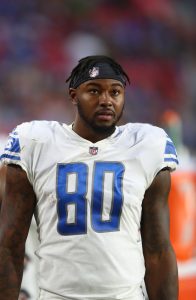 With the Lions waiving Roberts after their trade with the Patriots fell through, he may have an opportunity in Green Bay. The Packers claimed the third-year tight end off waivers Monday, Josh Alper of Pro Football Talk notes.
With the Lions waiving Roberts after their trade with the Patriots fell through, he may have an opportunity in Green Bay. The Packers claimed the third-year tight end off waivers Monday, Josh Alper of Pro Football Talk notes.
The Lions did not use an injury designation when waiving Roberts. He will join a more crowded tight end contingent with the Packers than he would have with the Patriots. Jimmy Graham, Lance Kendricks and third-round pick Jace Sternberger reside on Green Bay’s depth chart. The Packers also claimed tight end Pharoah McKever off waivers from the Jaguars recently.
Roberts, 25, has 13 career receptions for 146 yards. The Toledo alum, who caught three touchdown passes last season despite playing in just eight games, retains practice squad eligibility. Roberts suffered a shoulder injury that resulted in the former fourth-round pick finishing the 2018 season on IR.
Extension Candidate: Julio Jones
After skipping voluntary OTAs, Falcons star Julio Jones reported for the team’s mandatory minicamp earlier this month. There’s clear mutual interest in a new deal, but Jones’ situation is trickier than most. 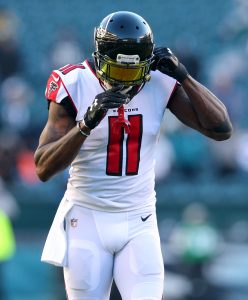
Jones is one of the league’s most accomplished wide receivers, but figuring out a multi-year extension for a 30-year-old skill player is never easy. He’s topped 1,400 receiving yards in each of the last five seasons, but it’s hard to bank on his speed holding up across multiple seasons.
Still, Jones led the league with 1,677 receiving yards in 2018 and continues to draw double coverage from overwhelmed defenses on a regular basis. And, while his contract has two more years to go, the Falcons cannot risk a rift – or a holdout – with their most potent offensive weapon.
A fresh deal for Jones would likely take him through the end of his career, but what would such an add-on look like? Currently, Jones’ salary has him ranked just 12th among wide receivers with an average annual value of $14.25MM. Making Jones No. 1 in AAV would mean vaulting him ahead of Antonio Brown‘s $19.8MM/year and Odell Beckham Jr.’s $18MM/year, which should be doable for the Falcons. However, Jones is unlikely to match the length of OBJ’s contract or, more importantly, the guarantees.
Beckham’s five-year, $90MM extension granted him $65MM in total guarantees and a whopping $41MM guaranteed at signing. Jones, who is already under contract through his age 32 season, is probably looking at no more than an additional three years. From there, you can expect a hefty signing bonus, and a decent sum scheduled for Year One of the new deal, but it’s unrealistic to expect the Falcons to ensure $41MM to the aging superstar.
So, how can the two sides reach an accord that is satisfactory for everyone? Recently, Joel Corry of CBSSports.com suggested the following:
- Length: Three years
- New money total: $60MM (Bringing total remaining value to $81MM over five years)
- Signing bonus: $25MM
- Guaranteed money: $50.526MM
- Fully guaranteed at signing: $37.526MM
Ultimately, that amounts to a $20MM average annual value, allowing Jones to edge Brown and OBJ in that category. Meanwhile, the Falcons preserve some flexibility, as Jones’ total guarantees would be $14.475MM shy of OBJ’s.
A new deal for Jones and the Falcons seems like an inevitability, but it will be interesting to see when they get it done, how they get it done, and what the cashflow of the extension looks like.
Josh McCown Retires From NFL
After 17 years in the NFL, Josh McCown is calling it a career. On Monday, the longtime QB bid farewell to the game in a post on The Player’s Tribune. 
“At the end of the day, no matter what team I was on, I tried to serve it to the best of my ability, and I tried to influence my team in a positive manner. I hope I did that,” McCown wrote. “And I made sure that when my number was called, I was prepared, and I gave it everything I had, every time. I may not have turned out to be the franchise quarterback I set out to be back at Cardinals rookie camp, but I’m extremely proud of the career I had.”
McCown didn’t become the face of the Cardinals as he had hoped, but he did enjoy nearly two decades in the NFL while spending time with ten different teams. His journey also included a pit stop in the UFL in 2010, a deal that almost didn’t come to pass when the Bears offered him a contract. Remarkably, McCown declined the opportunity in Chicago and stuck it out with the Hartford Colonials. He later said that the notion of bailing on the commitment “didn’t sit well” with him and he didn’t want to set a bad example for his children in which he would give his “word to somebody until something better comes along and then break that.”
McCown had some memorable moments on the field throughout his career, but he will largely be remembered for his high-character, intense work ethic, and willingness to help groom younger quarterbacks. After starting 13 games for the Jets in 2017, McCown put his ego aside and agreed to return to New York as a mentor for rookie Sam Darnold. Now, McCown will continue to put his football wisdom and knowledge to good use, either as a broadcaster or coach.
Contract Guarantees
Unlike in the NBA or MLB, players’ contracts in the NFL aren’t guaranteed by default. Typically, an NFL player will receive at least some guaranteed money when he signs a deal, but that money often comes in the form of contract bonuses, and in particular signing bonuses. While a player’s base salary, or P5 salary, will occasionally be guaranteed for a season or two, more often than not future seasons in that contract are fully non-guaranteed, allowing the team to escape the contract without much of a cap hit, particularly if the player’s bonus money was limited. 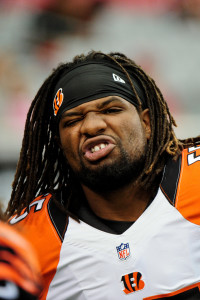
Take Vontaze Burfict for example. The linebacker inked a three-year, $33MM extension with the Bengals in 2017 with just $3.3MM in total guarantees. Rather than carrying Burfict at a $7.3MM cap figure in 2018, the Bengals released him in March, leaving just $1.8MM in dead money against $5.5MM in savings. At the time of signing, Burfict was ticketed to be the highest-paid 4-3 outside linebacker in the game on a per-year basis, but the Bengals were able to pull the plug and pay out only a portion of that commitment.
Signing bonuses, which are generally paid in one or two lump sums, are fairly straightforward forms of guaranteed money, but not all guaranteed money is created equal. We saw a prime example of that when Colin Kaepernick inked a long-term extension with the 49ers in 2014. When word of the agreement first broke, Kaepernick’s guaranteed money was reported to exceed $60MM+. However, upon learning the full details of the contract, we found that only about $13MM of that total was fully guaranteed, whereas another $48MM+ was guaranteed for injury only.
An injury-only guarantee is one of three types of guarantees that a team can write into a player’s contract that apply to his base salary in a given season. These guarantees are as follows:
- Guaranteed for injury: If a player suffers a football injury and cannot pass a physical administered by the team doctor, he would still be entitled to his full salary if the team were to release him. For a player like Kaepernick who has several future seasons guaranteed for injury only, it would take a career-ending injury for the Niners to be on the hook for all those future injury-only guaranteed salaries.
- Guaranteed for skill: The most subjective of the three, a player whose talents have significantly declined and is released for skill-related reasons (ie. another player beats him out for a roster spot) would still be entitled to his full salary if that salary is guaranteed for skill.
- Guaranteed for cap purposes: This form of guarantee ensures that a player who is released due to his team’s need to create cap room will still be entitled to his full salary.
A team can use a combination of these forms of guarantees, making a player’s salary guaranteed for injury and skill, for example. In the event that a player’s salary is guaranteed for injury, skill, and cap purposes, we’d refer to that salary as fully guaranteed, since the player would be eligible for his full salary regardless of the reason for his release.
As is the case with prorated bonuses, all future guaranteed salary owed to a player by a team is considered “dead money” and would accelerate onto the club’s current cap in the event of his release (over one or two years, depending on whether the cut happens after June 1). For the most part though, beyond the first year or two of a deal, that prorated signing bonus money is the only guaranteed figure remaining on the contract, which is why teams often don’t have qualms about releasing a player in the later years of his deal.
Note: This is a PFR Glossary entry. Our glossary posts will explain specific rules relating to free agency, trades, or other aspects of the NFL’s Collective Bargaining Agreement. Information from Over the Cap was used in the creation of this post. This post was modified from an early entry by editor emeritus Luke Adams.
